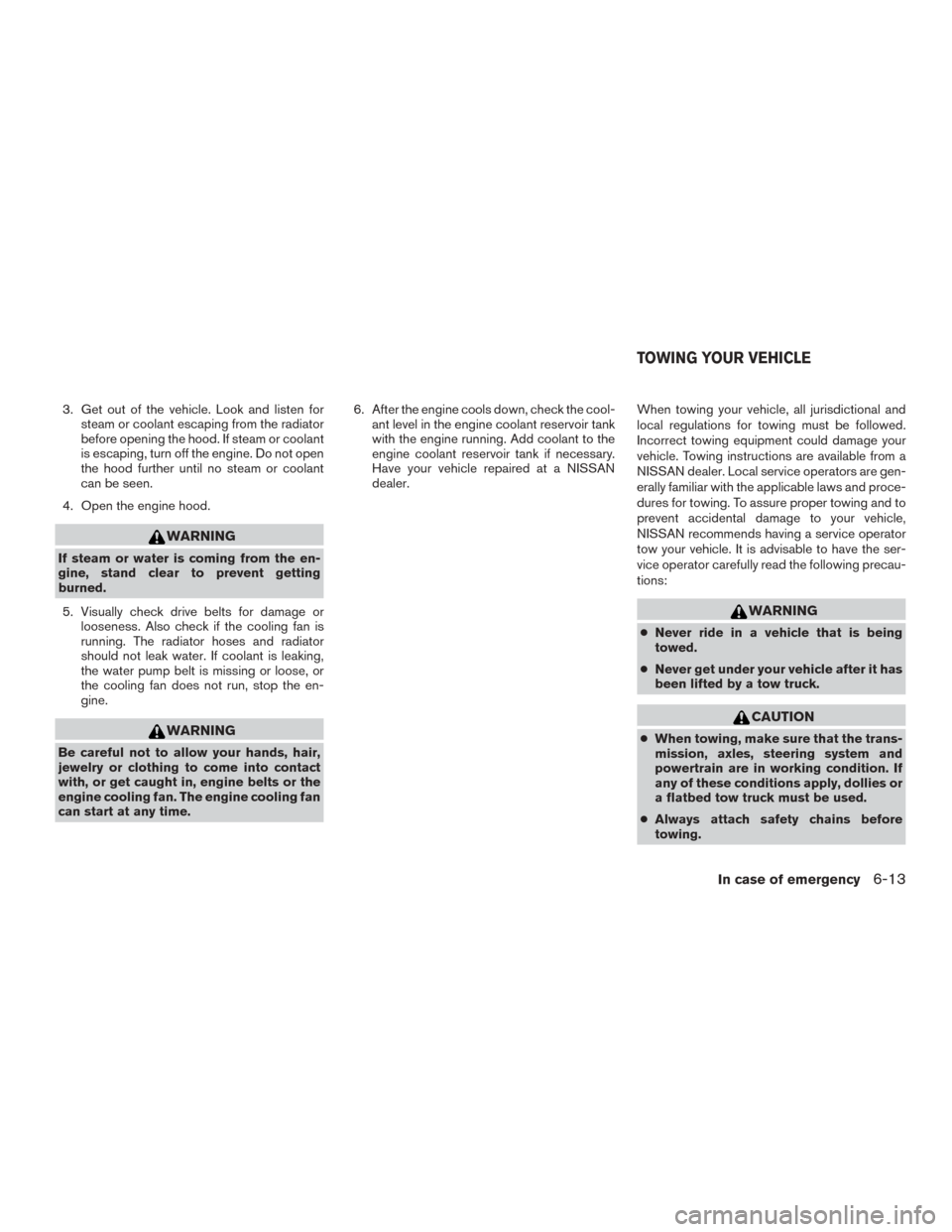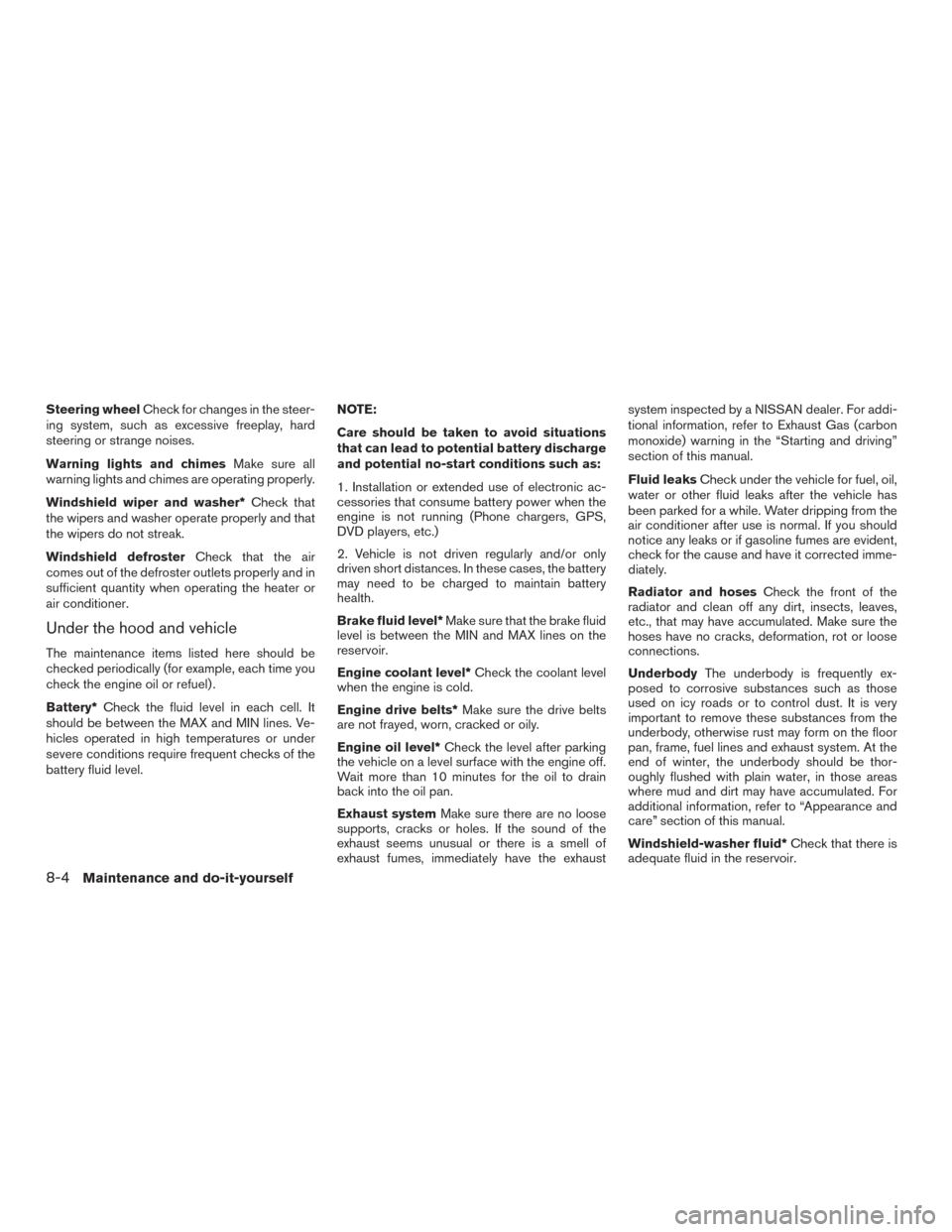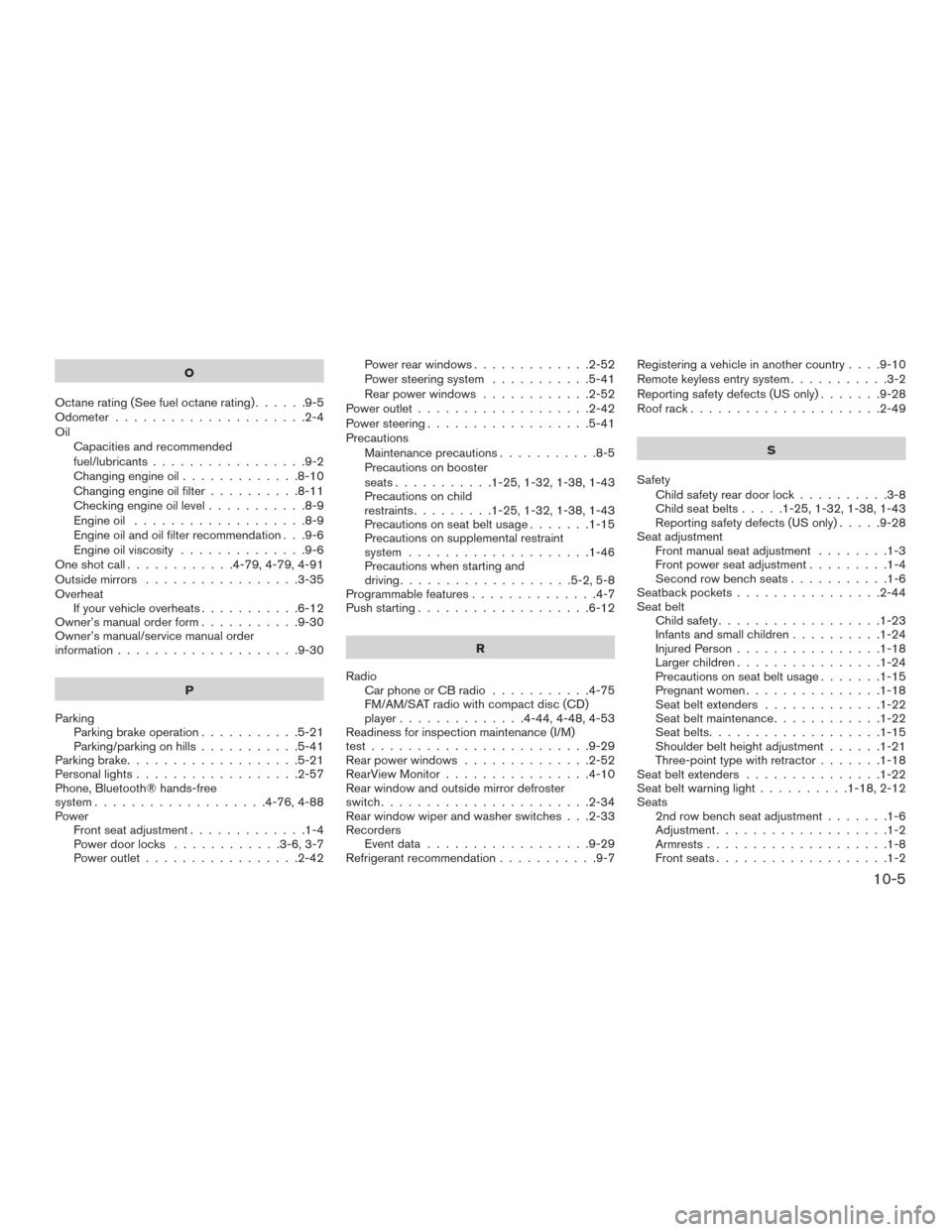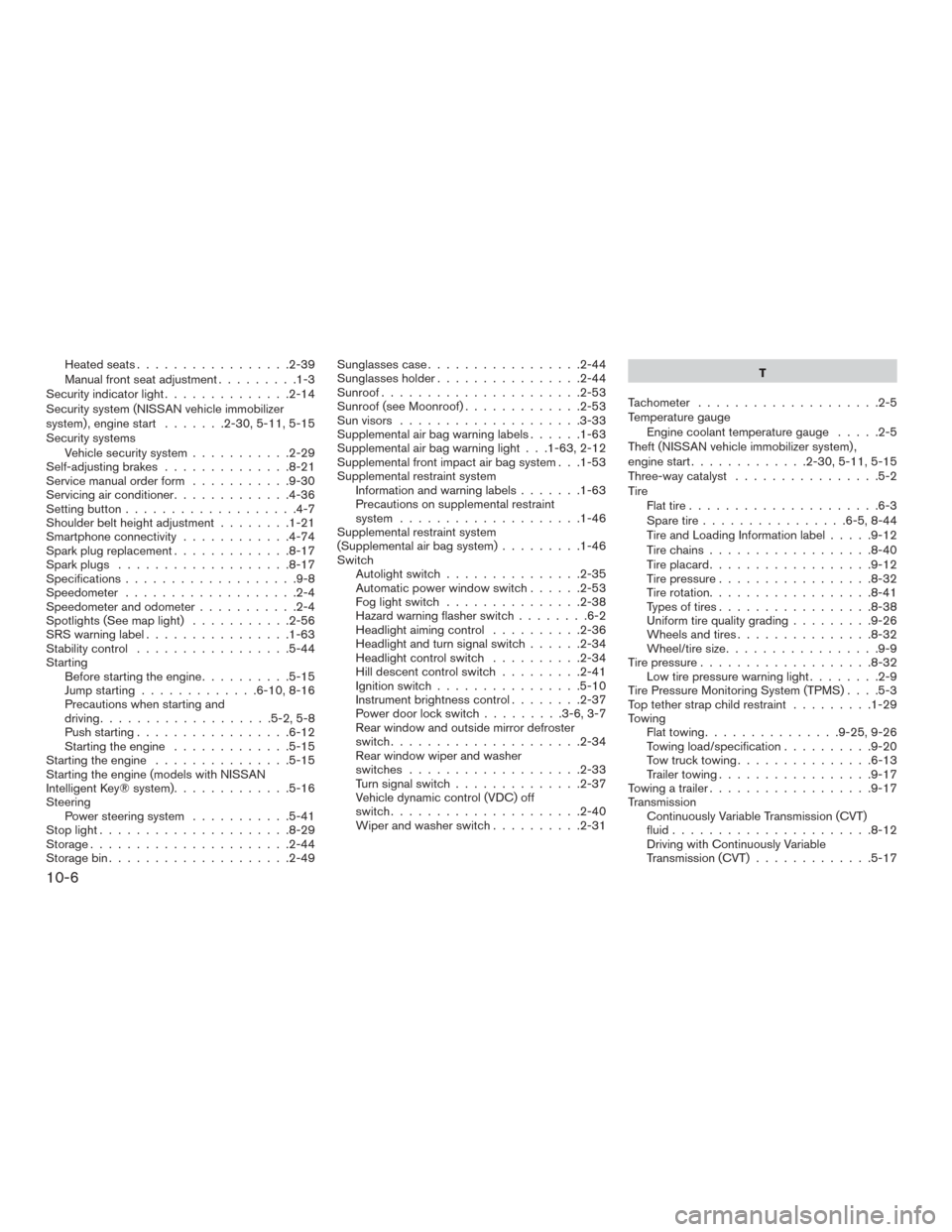2015 NISSAN ROGUE power steering
[x] Cancel search: power steeringPage 348 of 440

3. Get out of the vehicle. Look and listen forsteam or coolant escaping from the radiator
before opening the hood. If steam or coolant
is escaping, turn off the engine. Do not open
the hood further until no steam or coolant
can be seen.
4. Open the engine hood.
WARNING
If steam or water is coming from the en-
gine, stand clear to prevent getting
burned.
5. Visually check drive belts for damage or looseness. Also check if the cooling fan is
running. The radiator hoses and radiator
should not leak water. If coolant is leaking,
the water pump belt is missing or loose, or
the cooling fan does not run, stop the en-
gine.
WARNING
Be careful not to allow your hands, hair,
jewelry or clothing to come into contact
with, or get caught in, engine belts or the
engine cooling fan. The engine cooling fan
can start at any time. 6. After the engine cools down, check the cool-
ant level in the engine coolant reservoir tank
with the engine running. Add coolant to the
engine coolant reservoir tank if necessary.
Have your vehicle repaired at a NISSAN
dealer. When towing your vehicle, all jurisdictional and
local regulations for towing must be followed.
Incorrect towing equipment could damage your
vehicle. Towing instructions are available from a
NISSAN dealer. Local service operators are gen-
erally familiar with the applicable laws and proce-
dures for towing. To assure proper towing and to
prevent accidental damage to your vehicle,
NISSAN recommends having a service operator
tow your vehicle. It is advisable to have the ser-
vice operator carefully read the following precau-
tions:
WARNING
●
Never ride in a vehicle that is being
towed.
● Never get under your vehicle after it has
been lifted by a tow truck.
CAUTION
● When towing, make sure that the trans-
mission, axles, steering system and
powertrain are in working condition. If
any of these conditions apply, dollies or
a flatbed tow truck must be used.
● Always attach safety chains before
towing.
TOWING YOUR VEHICLE
In case of emergency6-13
Page 361 of 440

Steering wheelCheck for changes in the steer-
ing system, such as excessive freeplay, hard
steering or strange noises.
Warning lights and chimes Make sure all
warning lights and chimes are operating properly.
Windshield wiper and washer* Check that
the wipers and washer operate properly and that
the wipers do not streak.
Windshield defroster Check that the air
comes out of the defroster outlets properly and in
sufficient quantity when operating the heater or
air conditioner.
Under the hood and vehicle
The maintenance items listed here should be
checked periodically (for example, each time you
check the engine oil or refuel) .
Battery* Check the fluid level in each cell. It
should be between the MAX and MIN lines. Ve-
hicles operated in high temperatures or under
severe conditions require frequent checks of the
battery fluid level. NOTE:
Care should be taken to avoid situations
that can lead to potential battery discharge
and potential no-start conditions such as:
1. Installation or extended use of electronic ac-
cessories that consume battery power when the
engine is not running (Phone chargers, GPS,
DVD players, etc.)
2. Vehicle is not driven regularly and/or only
driven short distances. In these cases, the battery
may need to be charged to maintain battery
health.
Brake fluid level*
Make sure that the brake fluid
level is between the MIN and MAX lines on the
reservoir.
Engine coolant level* Check the coolant level
when the engine is cold.
Engine drive belts* Make sure the drive belts
are not frayed, worn, cracked or oily.
Engine oil level* Check the level after parking
the vehicle on a level surface with the engine off.
Wait more than 10 minutes for the oil to drain
back into the oil pan.
Exhaust system Make sure there are no loose
supports, cracks or holes. If the sound of the
exhaust seems unusual or there is a smell of
exhaust fumes, immediately have the exhaust system inspected by a NISSAN dealer. For addi-
tional information, refer to Exhaust Gas (carbon
monoxide) warning in the “Starting and driving”
section of this manual.
Fluid leaks
Check under the vehicle for fuel, oil,
water or other fluid leaks after the vehicle has
been parked for a while. Water dripping from the
air conditioner after use is normal. If you should
notice any leaks or if gasoline fumes are evident,
check for the cause and have it corrected imme-
diately.
Radiator and hoses Check the front of the
radiator and clean off any dirt, insects, leaves,
etc., that may have accumulated. Make sure the
hoses have no cracks, deformation, rot or loose
connections.
Underbody The underbody is frequently ex-
posed to corrosive substances such as those
used on icy roads or to control dust. It is very
important to remove these substances from the
underbody, otherwise rust may form on the floor
pan, frame, fuel lines and exhaust system. At the
end of winter, the underbody should be thor-
oughly flushed with plain water, in those areas
where mud and dirt may have accumulated. For
additional information, refer to “Appearance and
care” section of this manual.
Windshield-washer fluid* Check that there is
adequate fluid in the reservoir.
8-4Maintenance and do-it-yourself
Page 436 of 440

O
Octanerating(Seefueloctanerating)......9-5
Odometer .....................2-4
Oil Capacities and recommended
fuel/lubricants .................9-2
Changing engine oil .............8-10
Changing engine oil filter ..........8-11
Checking engine oil level ...........8-9
Engine oil ...................8-9
Engine oil and oil filter recommendation . . .9-6
Engine oil viscosity ..............9-6
Oneshotcall............4-79,4-79,4-91
Outside mirrors .................3-35
Overheat Ifyourvehicleoverheats...........6-12
Owner’s manual order form ...........9-30
Owner’s manual/service manual order
information ....................9-30
P
Parking Parking brake operation ...........5-21
Parking/parking on hills ...........5-41
Parking brake ...................5-21
Personallights..................2-57
Phone, Bluetooth® hands-free
system ...................4-76,4-88
Power Front seat adjustment .............1-4
Power door locks ............3-6,3-7
Power outlet .................2-42 Power rear windows
.............2-52
Power steering system ...........5-41
Rear power windows ............2-52
Power outlet ...................2-42
Power steering ..................5-41
Precautions Maintenance precautions ...........8-5
Precautions on booster
seats...........1-25,1-32,1-38,1-43
Precautions on child
restraints .........1-25,1-32,1-38,1-43
Precautions on seat belt usage .......1-15
Precautions on supplemental restraint
system ....................1-46
Precautions when starting and
driving ...................5-2,5-8
Programmablefeatures..............4-7
Push starting ...................6-12
R
Radio Car phone or CB radio ...........4-75
FM/AM/SAT radio with compact disc (CD)
player ..............4-44,4-48,4-53
Readiness for inspection maintenance (I/M)
test........................9-29
Rear power windows ..............2-52
RearView Monitor ................4-10
Rear window and outside mirror defroster
switch .......................2-34
Rear window wiper and washer switches . . .2-33
Recorders Eventdata..................9-29
Refrigerant recommendation ...........9-7Registering a vehicle in another country
....9-10
Remote keyless entry system ...........3-2
Reporting safety defects (US only) .......9-28
Roof rack .....................2-49
S
Safety Child safety rear door lock ..........3-8
Child seat belts .....1-25,1-32,1-38,1-43
Reporting safety defects (US only) .....9-28
Seat adjustment Front manual seat adjustment ........1-3
Front power seat adjustment .........
1-4
Secondrowbenchseats...........1-6
Seatbackpockets................2-44
Seat belt Child safety ..................1-23
Infants and small children ..........1-24
Injured Person ................1-18
Largerchildren................1-24
Precautions on seat belt usage .......1-15
Pregnant women ...............1-18
Seatbeltextenders .............1-22
Seatbeltmaintenance............1-22
Seatbelts...................1-15
Shoulder belt height adjustment ......1-21
Three-point type with retractor .......1-18
Seat belt extenders ...............1-22
Seatbeltwarninglight..........1-18,2-12
Seats 2nd row bench seat adjustment .......1-6
Adjustment ...................1-2
Armrests....................1-8
Frontseats...................1-2
10-5
Page 437 of 440

Heatedseats.................2-39
Manual front seat adjustment.........1-3
Security indicator light ..............2-14
Security system (NISSAN vehicle immobilizer
system) , engine start .......2-30,5-11,5-15
Security systems Vehicle security system ...........2-29
Self-adjusting brakes ..............8-21
Service manual order form ...........9-30
Servicing air conditioner .............4-36
Setting button ...................4-7
Shoulder belt height adjustment ........1-21
Smartphone connectivity ............4-74
Spark plug replacement .............8-17
Spark plugs ...................8-17
Specifications ...................9-8
Speedometer ...................2-4
Speedometer and odometer ...........2-4
Spotlights(Seemaplight) ...........2-56
SRS warning label ................1-63
Stability control .................5-44
Starting Before starting the engine ..........5-15
Jump starting .............6-10,8-16
Precautions when starting and
driving ...................5-2,5-8
Push starting .................6-12
Starting the engine .............5-15
Starting the engine ...............5-15
Starting the engine (models with NISSAN
Intelligent Key® system) .............5-16
Steering Power steering system ...........5-41
Stoplight.....................8-29
Storage......................2-44
Storagebin....................2-49 Sunglassescase.................2-44
Sunglassesholder................2-44
Sunroof......................2-53
Sunroof(seeMoonroof).............2-53
Sun visors
....................3-33
Supplemental air bag warning labels ......1-63
Supplemental air bag warning light . . .1-63, 2-12
Supplemental front impact air bag system . . .1-53
Supplemental restraint system Information and warning labels .......1-63
Precautions on supplemental restraint
system ....................1-46
Supplemental restraint system
(Supplemental air bag system) .........1-46
Switch Autolightswitch...............2-35
Automatic power window switch ......2-53
Foglightswitch ...............2-38
Hazard warning flasher switch ........6-2
Headlightaimingcontrol ..........2-36
Headlight and turn signal switch ......2-34
Headlight control switch ..........2-34
Hill descent control switch .........2-41
Ignition switch ................5-10
Instrument brightness control ........2-37
Power door lock switch .........3-6,3-7
Rear window and outside mirror defroster
switch.....................2-34
Rear window wiper and washer
switches...................2-33
Turn signal switch ..............2-37
Vehicle dynamic control (VDC) off
switch.....................2-40
Wiperandwasherswitch..........2-31 T
Tachometer ....................2-5
Temperature gauge Engine coolant temperature gauge .....2-5
Theft (NISSAN vehicle immobilizer system) ,
engine start .............2-30,5-11,5-15
Three-way catalyst ................5-2
Tire Flat tire .....................6-3
Spare tire ................
6-5,8-44
Tire and Loading Information label .....9-12
Tire chains ..................8-40
Tire placard ..................9-12
Tire pressure .................8-32
Tire rotation..................8-41
Types of tires .................8-38
Uniform tire quality grading .........9-26
Wheels and tires ...............8-32
Wheel/tire size .................9-9
Tirepressure...................8-32 Low tire pressure warning light ........2-9
Tire Pressure Monitoring System (TPMS) ....5-3
Top tether strap child restraint .........1-29
Towing Flattowing...............9-25,9-26
Towing load/specification ..........9-20
Towtrucktowing...............6-13
Trailer towing .................9-17
Towing a trailer ..................9-17
Transmission Continuously Variable Transmission (CVT)
fluid......................8-12
Driving with Continuously Variable
Transmission (CVT) .............5-17
10-6